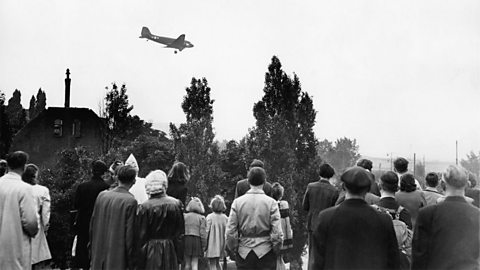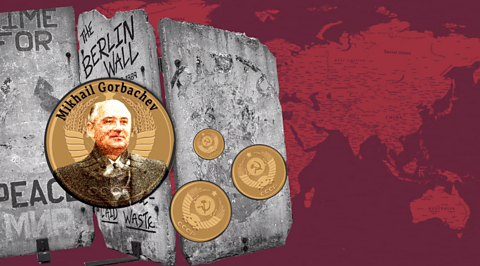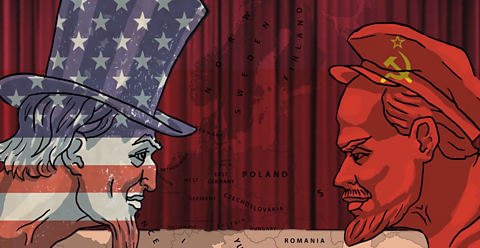Key points
- When World War Two ended in 1945, there was hope that the wartime allies - the UK, America and Soviet Union - could work together to build a peaceful future.
- However, relations between the capitalismA system of running a country where most businesses are owned by private companies or individuals, not the government. US and the communismA system of running a country in which all means of production such as tools, factories and raw materials, are owned by the community as a whole. Private property does not exist and each individual contributes according to their ability and receives according to their needs. This means there is no hierarchy of social class. Soviet Union quickly deteriorated, leading to 45 years of tension, a nuclear arms race and a constant threat of nuclear war.
- Communism and capitalism are opposite ideologyA set of beliefs about how a country, or system, should work..
Video about the Cold War
Narrator: After World War Two, a 45-year struggle for global supremacy emerged: the Cold War. One side was led by the USA, the other by the Soviet Union - the two superpowers. The Soviet Union led one side with other Eastern European countries such as Hungary and Poland, whilst the USA was allied with countries such as France and Britain.
The conflict was about ideologies, how each side thought the world should be run. The USA and their allies supported a democratic system that gave economic power to individuals and companies: capitalism. The Soviets and their satellite states believed in communism, a political system where the government controls the economy and the people work collectively.
A symbolic Iron Curtain cut through the middle of Europe: East vs West. It was called the Cold War, as the two sides never directly fought. But they battled each other in different ways. Proxy wars were wars fought in or between other countries, with each side getting financial and military support from either the Soviets or the Americans. So the two sides were indirectly fighting each other.
These wars happened in Korea, Algeria, Vietnam, Afghanistan and other countries. Both the USA and the Soviets spent huge amounts of money on their military and nuclear weapons, trying to outdo each other, creating an Arms Race. The world came very close to nuclear war during the Cuban Missile Crisis of 1962.
Each side also tried to show their technological superiority in the space race. The Soviets sent the first people into space, but the Americans achieved the first moon landing. During the Cold War, the threat of nuclear Armageddon was an everyday fear. By the 1980s, Mikhail Gorbachev was reforming the Soviet Union as they faced economic problems and individual countries were demanding independence.
In 1991 the Soviet Union split up and the Cold War ended.
Key events in the early years of the Cold War
The Yalta Conference
In February 1945, the leaders of the UK, America and the Soviet Union met in Yalta in the Crimean region of the Soviet Union. After winning World War Two, these powers became known as the Big Three. They met to discuss what would happen in Europe after Nazi Germany was defeated.
Joseph Stalin (Soviet Union), Franklin Roosevelt (USA) and Winston Churchill (UK)decided that Germany would be split into four zones. The Soviet Union, USA, UK and France would each control a zone. The German capital Berlin, which was in the Soviet zone, would also be divided into four.
It was also decided that there should be free and fair elections in Eastern European countries that were now free from Nazi control. In the meantime, the Soviet Union was to be allowed a ‘sphere of influence’ over these countries, where communismA system of running a country in which all means of production such as tools, factories and raw materials, are owned by the community as a whole. Private property does not exist and each individual contributes according to their ability and receives according to their needs. This means there is no hierarchy of social class. values would dominate.
The Soviet Union also agreed to support the USA in the war against Japan.
The Potsdam Conference
The Big Three met again five months later in Potsdam, just outside of Berlin, in July 1945. Things had changed a lot since the Yalta Conference. Nazi Germany had been defeated and the war in Europe was over.
There had been a change in leaders too. The British Prime Minister, Winston Churchill, had lost a general election and had been replaced by Clement Attlee. The American President Franklin Roosevelt had died and was replaced with Harry Truman. This change in leadership meant that a lot of the personal relationships were lost.
Truman thought Roosevelt had been too lenient with Stalin and communism. During the conference, he found out that an American test of the atom bombA nuclear weapon that releases a huge amount of energy by splitting atoms. They can cause enormous amounts of death and damage when dropped on an area. had been successful. This meant he no longer needed Soviet help in the war against Japan. Truman also felt that Stalin was failing to keep the agreement made at the Yalta Conference, that there would be free and fair elections in Eastern Europe.
The Potsdam Conference formally agreed the division of Germany into four zones, but failed to settle other important issues. Some historians have argued that these tensions between the Big Three helped to set the stage for the Cold War.
What were the differences between the Yalta and Potsdam conferences?
There were three main differences:
- The Yalta Conference took place during World War Two. By the Potsdam Conference, Nazi Germany had been defeated, although the war in Japan continued.
- There had been a change in leadership in the UK and USA meaning personal relationships were lost.
- There was a change in the atmosphere at the Potsdam Conference. Truman wanted to be tougher on communism, thought Stalin wasn't keeping promises and knew that the America had successfully tested an atom bomb so no longer needed Soviet help in the war against Japan.
Soviet control in Eastern Europe
Between 1945 and 1949, Stalin worked on putting Soviet-friendly governments into Eastern European countries, such as Poland, Romania, Czechoslovakia and Bulgaria. Opponents to the Soviets were arrested and many elections were rigged.
Stalin argued that Russia had been attacked twice by Germany in the twentieth century, so a buffer zoneA neutral area that separates two conflicting areas or countries. around Russia would help to protect them.
Winston Churchill gave a speech in 1946 saying “an Iron Curtain has descended across Europe.” This phrase became commonly used to explain the divide in Europe, between a communist Eastern blocCountries in Eastern Europe that were controlled by the Soviet Union, for example Poland, Hungary and Czechoslovakia. and a capitalist WestCountries run by a system in which most businesses are owned by private companies or individuals, not the government. This included much of Western Europe and the US. .
The Truman Doctrine and Marshall Plan
America was concerned about the spread of communism and feared the Soviet Union would take advantage of the poverty in Eastern European countries that were still recovering from the effects of World War Two. There were also concerns that western countries such as France or Italy may turn to communism as they looked to recover from the war.
Harry Truman gave a notable speech in 1947 called the ‘Truman Doctrine’. In this speech, he pledged that America would do whatever they could to support European countries and stop the spread of communism, pledging $400 million to Greece and Turkey for economic and military aid.
This was followed up in 1948 with the Marshall Plan. General George Marshall visited European countries to see the extent of the support needed for their recovery. Marshall had been Chief of Staff in the American army in World War Two and was then appointed Secretary of State. He had seen first-hand the damage that the war had done to European countries.
A system was set up where countries could apply for loans from America. In total, around $13 billion was given out across Europe in grants and loans. Stalin forbade any eastern bloc countries from accepting the offer of aid, claiming that the Marshall Plan was a way for America to interfere with the domestic affairs of other countries.
The Berlin blockade and Airlift
The Marshall PlanAn American programme of funding established in 1948, which aimed to help western European countries recover after World War Two. More than $13 billion was given to help western countries strengthen their economies. was highly effective in helping the western zones of Germany to make a strong economic recovery. The countries who controlled the western zones - America, UK, and France - introduced a new currency, the Deutsche Mark, in an attempt to settle the economy down. But this angered Stalin. At the Yalta Conference it was agreed they would work towards reuniting Germany – and the new currency in the American, French and British zones made this less likely.
In response, Stalin blocked all land borders into West Berlin. This stopped food, medicine and supplies being transported into western zones by road, railway or canal. Some historians believe that Stalin was hoping the western allies would abandon their zones in Berlin.
General Clay, who was in charge of the American troops in Berlin, wanted to break through the blockade. He believed that the Soviet Union would not dare risk war as America was the world’s only nuclear power at the time. He was persuaded by his superiors against this course of action and instead America, the UK, and France launched an airlift from the west German zones into West Berlin. They carried in coal, food, medicine and other supplies the people of West Berlin needed. At the height of the Berlin Airlift, a plane was landing in West Berlin every minute.
Stalin did not shoot down these planes as they were flying in air corridors that had been agreed at the Yalta Conference. He also didn’t want to risk a war with America.
After eleven months, the Soviets realised that America would not give up West Berlin, so the blockade was lifted on 12th May 1949. It was a major propaganda victory for the West and Berlin became a symbol of the allies’ keenness to oppose further soviet expansion. The Soviets had failed in their objective of forcing the UK, America, and France out of West Berlin.

NATO and the Warsaw Pact
In April 1949, twelve countries joined the North Atlantic Treaty Organisation (NATO). The founding members were the UK, America, France, Belgium, Canada, Denmark, Iceland, Italy, Luxembourg, the Netherlands, Norway and Portugal.
The key agreement was the principle that an attack on one member would be considered an attack on them all. This was seen as a way to protect western countries against Soviet aggression. West Germany joined NATO in May 1955 after the UK, France and America ended their military occupation of their respective zones in West Germany.
In response to West Germany joining NATO, the Soviet Union set up the Warsaw Pact in May 1955.The Warsaw Pact had eight founder members: the Soviet Union, Albania, Bulgaria, Czechoslovakia, East Germany, Hungary, Poland and Romania. They also made a similar commitment to defend each other.
Who was to blame for the start of the Cold War?
Historians have to evaluate the evidence for both sides of the argument and consider different historical interpretations.
After World War Two, the Soviet Union argued it needed protection against possible further attacks from Germany. To do this, it wanted communist governments in place across Eastern Europe. It was also concerned that America had not been open about the successful atom bomb at the Potsdam Conference, leading to feelings of mistrust and suspicion.
America felt the Soviet Union did not keep its promises about free and fair elections in Eastern Europe. The Americans argued that the Soviet Union was deliberately slowing economic recovery and support in Europe as they thought communism would spread more easily in poorer areas. The Truman Doctrine and Marshall Plan were both attempts by America to financially help poorer countries, to try to stop them becoming communist.
The mistrust and suspicion of each other led to a series of tense stand-offs throughout the Cold War.
Activity - order these events
Test your knowledge
GCSE exam dates 2025
Find out everything you need to know about the 2025 GCSE exams including dates, timetables and changes to exams to get your revision in shape.

More on The Cold War
Find out more by working through a topic
- count2 of 4

- count3 of 4

- count4 of 4
